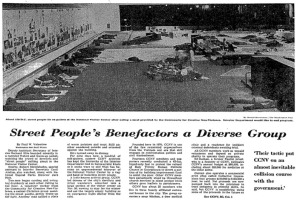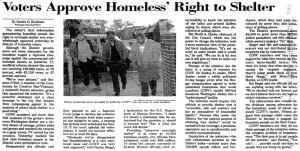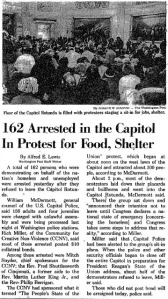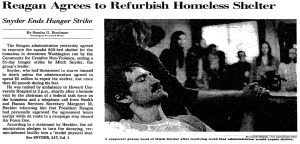The Federal City Shelter, which rests on 2nd Street NW between Avenue D and E and plays an integral role in serving DC’s homeless, only exists today as a result of the struggle led by the Community for Creative Non-Violence in the 1980s. This struggle, spearheaded by Mitch Snyder, was pivotal in raising the national consciousness about homelessness during that decade. Inspired by a radical branch of Christian pacifism, the group had its roots in the anti-war movement of the 1970s. As more and more people were left with out homes throughout the decade, the group shifted its focus to address the emerging crisis.

Following the loss of Fairmont House, CCNV turned its attention towards downtown where a growing number of people without homes found refuge on the heating grates. In late November of 1978, the group organized a takeover or “live-in” of an unused portion of the newly renovated National Visitor Center. Mitch Snyder argued the target was deliberately chosen because of its “natural organic centrality.”[1] With the action, the group shifted its strategic focus and brought the federal government into their struggle to address the needs of the homeless. The group demanded that more shelters open in the city and that the demeaning intake procedures at those that existed be eliminated. Officials at the Department of the Interior warily watched as close to 200 people joined the group each night. In the second week, they ordered the shelter closed, and CCNV led a series of sit-ins that lead to nearly fifty arrests. As the pressure mounted and Christmas loomed, the city relented and agreed to meet the group’s demands.[2]
With this significant victory in hand, CCNV increasingly pressured the federal government to address the homeless crisis during the 1980s as President Ronald Reagan took office. On Thanksgiving Day 1981 CCNV established “Reaganville” in Lafayette Park, across from the White House. Intended to remind Americans of the dilapidated and ironically named “Hoovervilles” of the Great Depression in 1930s, this protest illuminated the plight of DC’s homeless and the dire need of a resolution to their problems. President Reagan, initially refused to accept that the federal government had any responsibility for the issue. He argued, “people who are sleeping on the grates…the homeless…are homeless, you might say, by choice.”[3] The city government continued to maintain that it had things under control as officials “denied … that the plight of the city’s homeless had reached crisis proportions.”[4] As both the federal and city government refused to even recognize that there even was a problem, CCNV redoubled its efforts to raise awareness about the plight of the homeless and successfully fought for the right to keep “Reaganville” open across from the White House throughout his administration.[5]

At the district level, the group became one of the primary backers of a referendum movement in 1984 to pass ballot Initiative-17, which sought to guarantee, “safe, sanitary, and accessible shelter space, offered in an atmosphere of reasonable dignity” for the homeless. Critics of I-17 argued that mandating housing for the homeless would result in their being warehoused, and that a great strain would be put on what was already an encumbered budget.[6] District of Columbia voters, however, overwhelmingly approved by a 72% margin Initiative-17, the nation’s first referendum guaranteeing homeless people the right to overnight shelter, on November 6, 1984.[7] Advocacy did not stop with the passage of Initiative-17, though, as Mary Ellen Hombs of the CCNV said, “The first step is to get people off the streets. You can’t…provide social services to people who are living on grates.”[8]

Throughout the Intiative-17 campaign, members of the CCNV continued to put pressure on the federal government. During Reagan’s 1983 State of the Union address, the group organized a sit-in at the Capitol Rotunda that resulted in 163 arrests. In December 1983, the Reagan administration shifted its approach to the group and agreed to turn over the vacant Federal City College building on 2nd Street to use as an emergency winter shelter.[9] In January 1984 the group moved into the 2nd Street building as members of Congress held a hearing and press-conference in the building’s basement.[10] After the event, Justin Brown of the CCNV said that “…to date our greatest obstacle has been simply lack of recognition of the size of the problem….here it’s visible.”[11] Despite poor conditions that made the occupants susceptible to health problems and vulnerable to fires, the building operated at capacity. At the shelter, anywhere from 600-1000 people seeking refuge came per night. As winter ended, the federal government threatened to evict the group to make way for the sale of the building, but relented after CCNV organized a large march to the White House.[12]

In an attempt to get the federal government to commit to rectify the abysmal conditions within the building, eleven CCNV members went on a fast. When asked “Do you think that eleven people fasting are going to change an entire administration’s policy,” Mitch Snyder answered “Oh, I think one decent person with enough commitment and enough integrity and enough concern for their neighbors could turn the world upside down.”[13] As it turned out those eleven people did have enough commitment. Mitch Snyder fasted for 51 days and ended his protest on Nov. 5th, the day before the 1984 Presidential election. He did so after long deliberations with the federal government ended with the government agreeing to renovate the shelter.[14]
The struggle for the shelter, however, was not over. After the election the Reagan administration rescinded its promise to rehabilitate the building and instead contracted with the DC Coalition for the Homeless to relocate the emergency shelter to Anacostia. Resisting the government’s effort to push the homeless out of public sight and also seeking to preserve the central access that the Federal City provided, Mitch Snyder and CCNV activists engaged in a new hunger strike. The Reagan administration relented and promised five million dollars towards the renovation of the Federal City Shelter. After completing the renovations, the federal government turned the building over to the city of Washington, DC on July 7, 1986 under the stipulation that it would serve as a shelter for at least thirty years.
Because of Snyder’s fast, visibility was no longer a problem for the CCNV and the homeless for whom they advocated. Both a 60 Minutes story and an Academy Award-nominated documentary titled Promises to Keep highlighted their struggle. With this great recognition CCNV was able to capitalize on its efforts and homeless issues made great gains thereafter. In 1987 President Reagan signed the Stewart B. McKinley Homeless Assistance Act into law. The legislation provided a major influx of federal funding for homeless social services across the country.
In time, the CCNV-operated Federal City Shelter became what Benjamin Forgey described as “a sight to see.”[15] With continued renovations with money from the government and donations provided by private companies, the group built kitchens, established a health clinic, and provided other essential services; “[it continues to operate] according to the long-recognized…principle of closely connecting services (medical, psychological, social) with the basic necessity of shelter….”[16] The shelter has the ability to incorporate up to 1,700 people into its fold per night, and has since 1987.[17] The Federal City Shelter has become, in Benjamin Forgey’s words, “a contribution to the neighborhood, a beckoning warm place, a hearth, a home.”[18]
[1] Washington Post, December 1, 1978.
[2] Washington Post, December 1, 1978, December 7, 1978, December 10, 1978, December 11, 1978, December 12, 1978, December 16, 1978
[3] Peter Dreier “Reagan’s Legacy: Homelessness in America,” Shelterforce Online No. 134 (May/June 2004), http://www.nhi.org/online/issues/135/reagan.html
[4] David Field “City Denies Crisis of Homelessness,” The Washington Post, Dec. 30, 1982
[5] Washington Post, March 10, 1983.
[6] Sandra G Boodman, “Voters Approve Homeless’ Right to Shelter,” The Washington Post, Nov. 7, 1984
[7] Ibid
[8] Ibid
[9] Washington Post, December 24, 1983.
[10] Alma Guillermoprieto and Ed Bruske, “Media Event Gives Shelter Dwellers a Warm Feeling,” The Washington Post, Jan. 27, 1984
[11] Ibid
[12] Washington Post, April 2, 1984; Promises to Keep, directed by Ginny Durrin (Washington, DC: Durrin Productions, 1988) DVD.
[13] Ibid
[14] Ibid
[15] Benjamin Forgey, “Model Havens for the Homeless; CCNV’s Spruced-up Shelter and a House for 12 Women: [FINAL Edition],” The Washington Post, Dec. 26, 1987
[16] Ibid
[17] Ibid
[18] Ibid